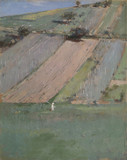Theodore Robinson (1852-1896), a pioneer of American Impressionist painting, was the only American artist to absorb the lessons of Impressionism through sustained contact with its greatest exponent, the French painter Claude Monet. Born in Townshend, Vermont, Robinson grew up there and in Evansville, Wisconsin. He studied art at the Art Institute of Chicago and at the National Academy of Design in New York City, where he participated in the founding of the city’s new art school, the Art Students League. In 1876 Robinson took the first of many trips to Europe, to study at the private studio of portraitist Carolus-Duran (Charles-Emile-Auguste Durand). He subsequently trained with the academic painter Jean-Léon Gérôme at the École des Beaux-Arts, Paris, and exhibited a painting at the French Salon of 1877. Returning to the United States in 1879, Robinson lived in New York, where mural work, his principal pursuit at that time, was plentiful. He worked for the decorative painter and muralist John La Farge on private and public projects and in 1883 secured a commission for decorations for the Metropolitan Opera House. By 1884 he had returned to Europe, visiting Barbizon, a forested area outside Paris that had inspired a fresh and direct style of landscape painting named after the region. Robinson may also have studied with Jean Joseph Benjamin Constant at this time. He traveled to Holland, and then returned to France, where he divided his time between Paris and the countryside. A decisive moment in his career came in 1887 when, together with the New England landscape painter Willard LeRoy Metcalf, he met Claude Monet at his home in Giverny, near Paris. There he viewed Monet’s Cathedral series and, deeply impressed by Monet’s atmospheric effects and strong compositions, transformed his own work by lightening his palette and building up form with dabs of brushwork similar to those of the French master. The two artists often worked together over the next few years. In 1889 Robinson exhibited his Impressionist works in America for the first time. He garnered several prestigious prizes, including the Society of American Artists’ Shaw Fund Award in 1892, and had a major retrospective at Macbeth Galleries in New York in 1895. Despite this critical acclaim, his work did not appeal to contemporary American collectors. Robinson continued to travel to Europe and throughout New England, New York and New Jersey, seeking outdoor subjects and teaching intermittently, until his abrupt and early death from asthma at the age of forty-three.
BIBLIOGRAPHY
Theodore Robinson (exh. cat. by J. I. H. Baur, New York, Brooklyn Mus., 1946) J. I. H. Baur: ‘Photographic Studies by an Impressionist’, Gaz. B.-A., n. s. 6, xxx (1946), pp. 319-30 Theodore Robinson (exh. cat., intro. Sona Johnston; Baltimore, MD, Mus. A., 1973) Theodore Robinson: His Life and Art (exh. cat. by E. C. Clark, Chicago, R. H. Love Gals, 1979) W. Gerdts: American Impressionism (Seattle, 1980), pp. 51-6 The Figural Images of Theodore Robinson (exh. cat. with intro. by W. Kloss, Oshkosh, WI, Paine A. Cent. & Arboretum, 1987) R. H. Love: Theodore Robinson: Sketchbook Drawings (Chicago, 1991)

